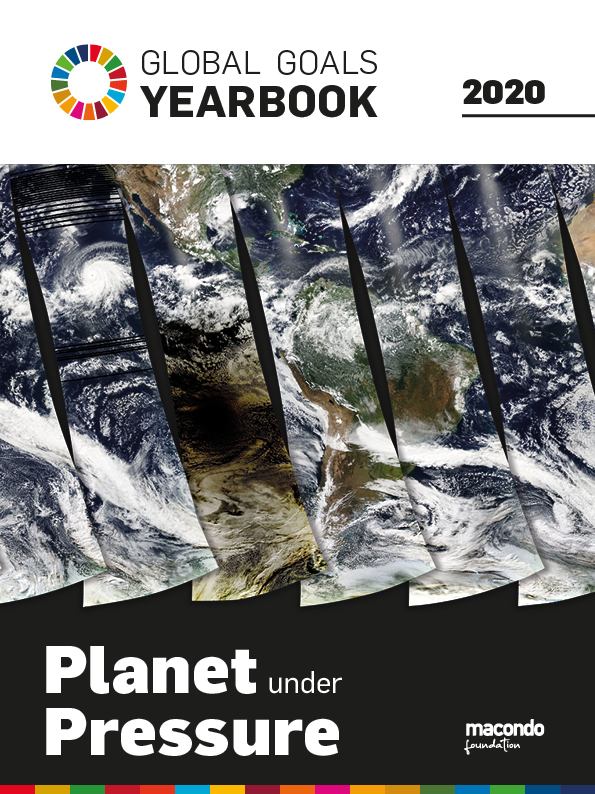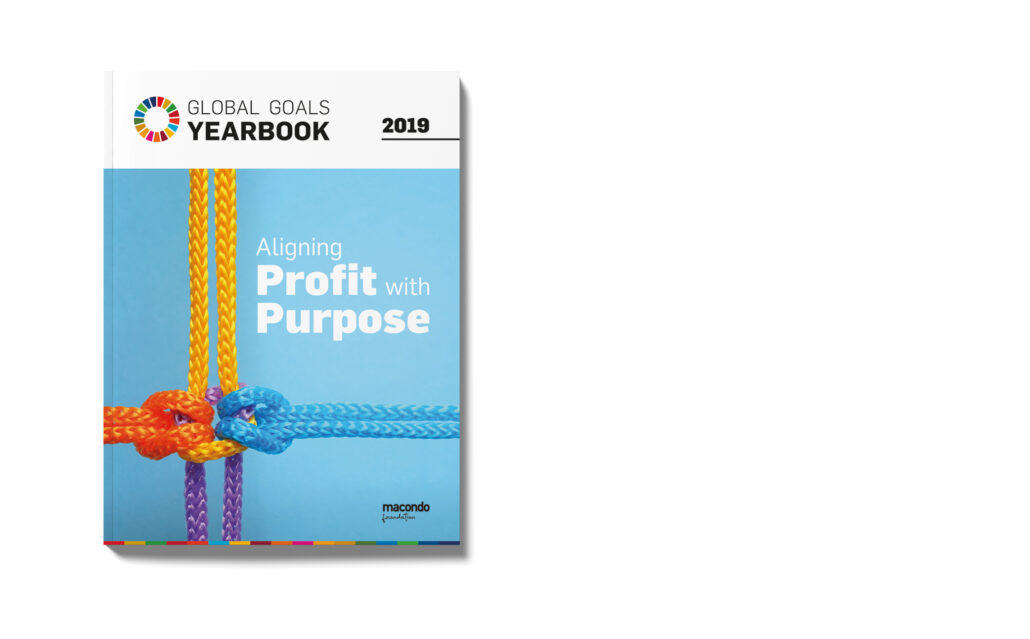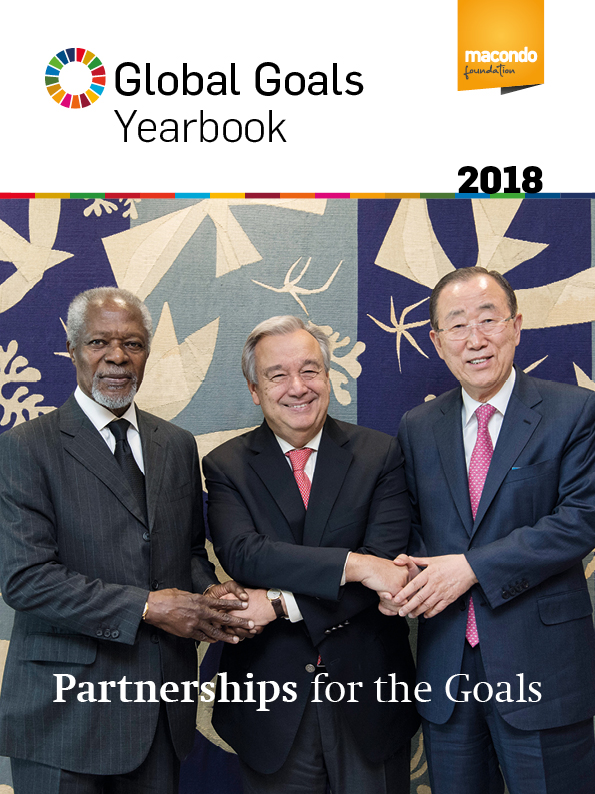According to a survey, almost two-thirds of large companies in the G20 countries say that dealing with the climate crisis and the resulting sustainability initiatives poses a major challenge for them. Forty-five percent lament the search for qualified staff as being a major problem. More than a quarter consider a sustainable supply chain to be a particularly difficult challenge. The war in Ukraine also shows that ESG is not a “nice to have,” but a fundamental part of management decisions.
In the professional world, the term ESG (environment, social, and governance criteria) is increasingly gaining acceptance. The term comes from the world of finance and is still very closely linked to it today, for example in the context of the EU financial taxonomy. In this chapter, the Global Goals Yearbook highlights the most important factors to keep in mind.
Rethinking ESG as a strategic driver for business transformation
ESG transformation involves risks, but it also offers opportunities for governments, companies, investors, and society by creating value through solving social and environmental problems. “Investors, lenders, and rating agencies expect greater visibility of non-financial metrics to better understand diverse social and environmental risks,” say Peter Grassmann, Casey Herman, and Colm Kelly, authors of the article “Are You Ready for the ESG Revolution?”
“Governments are forced to reduce emissions due to new regulations and taxes. Activist shareholders, among other stakeholders, are advocating for tighter linkages between ESG targets and executive compensation packages. And conscious consumers are voting with their wallets and valuing companies with purpose and diversity in their workforce,” the authors say.
According to a recent PwC survey, nearly 75 percent of organization leaders are still in the early stages of their ESG journey. A few companies, though, have begun reorienting their businesses toward a value-creation ecosystem that adds environmental sustainability, employee engagement, external partnerships, and broader social impact as measures of success. Whatever the starting point for the ESG dialogue, the project will require changes in all dimensions of a business, including strategic decision-making, implementation of the new direction, and reporting on progress and outcomes. In this sense, companies should tackle some important issues to build trust among – and deliver sustained outcomes to – their stakeholders.
- Reimagined reporting: Everything from carbon emissions to racial and gender balance are being assessed as ESG risks.
- Strategic reinvention: To make progress with new metrics, companies must rethink their ESG strategy and redefine not only what the business does, but how it does it.
- Business transformation: A business that begins to report on broader non-financial metrics will have to internalize ESG into its strategy and report on both progress and outcomes.
“Senior leaders have a critical role in driving this transformation agenda, which is not separate from ongoing digital transformation,” the authors say. Part of the challenge is the proliferation of ESG ratings and risk-assessment metrics that are based on different criteria. Not surprisingly, the “lack of reporting standards” was cited as the top barrier to ESG effectiveness by executives in the PwC survey.
Leading the transformation
ESG transformation requires leadership that is capable of connecting sustainability with the core business and focusing its investment portfolio on projects that are consistent with limiting global warming to 1.5°C above pre-industrial levels. But the reality is that in most organizations, this kind of leadership is still emerging, according to the PwC survey.
A second critical point for leaders is to balance ESG with growth targets and tight budgets. However, strong leaders could steer the conversation to the long-term financial benefits of shifting from unsustainable business based on fossil energy to sustainable production based on clean energy sources. When leaders focus and connect ESG goals with their business strategy, they can take advantage of the huge opportunities offered by the ESG transformation for value creation.
4.Zero: Digitalization meets decarbonization
Very often, ESG transformation comes together with digital transformation. Technology, through enterprise resource planning software, can help track, report, and reduce carbon impacts. The consequences of climate change are already happening worldwide. And according to the Intergovernmental Panel on Climate Change, even if all parties involved adhered to the measures agreed at the climate conference of Glasgow in 2021, the Earth would warm by 1.8°C by 2100. The EU has committed to reducing CO2 emissions by 55 percent by 2030 compared with 1990 levels and be climate-neutral by 2050. This is forcing many companies to redefine their business models.
Sustainability can have a similarly disruptive effect on companies, and even entire industries such as digitalization. And it holds enormous opportunities for companies that combine digital and sustainability transformation. In the First Movers Coalition, 55 corporations committed in 2021 to using products and services that are emissions-free. And 450 financial companies that hail from 45 countries and are member of the Glasgow Financial Alliance for Net-Zero want to align the management of $130 trillion with the net-zero target.
Fighting a talent war
There is a talent war for sustainability professionals, as firms have been hiring them at a rate not supported by the available supply. “Not all companies are looking to jump on the hiring bandwagon; for some, simply purchasing a suite of ESG data solutions and encouraging analysts to incorporate them into the research process can be a good enough start,” says Tom Strelczak, director of ESG & Responsible Investment at TWS Search Limited. “Rather than spending vast sums of money on band-aid measures, it could be better to invest in the up-and-coming talent that would learn and grow with the business,” the expert recommends. There are plenty of high profile universities offering sustainable investment courses. “If short-term measures are preferred to mid- to long-term measures, the options are to identify people with transferable skillsets,” he explains.
“Over the past few years, ESG requirements have increased dramatically, and it becomes important to understand the difference between the skepticism of ESG as a strategy and the skepticism of ESG hiring practices. The latter is what we are focused on: offering clients an opportunity to hire talent without falling foul of the artificially high compensation requirements in the market. A healthy debate around this topic will encourage companies to come up with solutions that do not add to the spiraling ESG-related wage inflation that can no longer be supported by the business,” Strelczak says.
“Some of the more mainstream asset managers leading the discussion around sustainable investing have hired all the available talent in the market at a price higher than the value they bring to the company itself,” Strelczak points out. “This has, in turn, caused salary inflation associated with ESG skillsets,” he warns. Therefore, companies should reorient their investments toward training junior talent for more sustainable growth plans.
However, the knock-on effect of hiring sustainability-focused candidates from outside of the financial services sector is the subsequent lack of investment focus, which in turn causes conflict with the business itself. “One of the main reasons for candidates to leave their job is that their firm does not take ESG seriously enough,” Strelczak says.
But he also observes a change in the market: The US Securities and Exchange Commission is investigating and restricting asset managers from falsely labeling funds, and these actions will give greater power to people in ESG roles who assess what companies go into which funds. Repurposing a senior investment director or portfolio manager as “Head of ESG” is a tactic being phased out by firms that acknowledge that greenwashing drives talent away from their companies.“Our firm takes an increasingly progressive approach to new client due diligence, making sure that the companies for whom we run searches are offering an attractive platform for ESG professionals in our network,” Strelczak affirms.
The best response is training
In 2021 the European Commission launched a Corporate Sustainability Reporting Directive (CSRD), which tightens the requirements for non-financial reporting. The CSRD applies to companies that have more than 250 employees and/or a €40 million turnover and/or €20 million in total assets. Approximately 49,000 companies throughout Europe are affected and have to produce sustainability reports from 2025 onwards.
Requirements:
- European companies will have to measure and report their greenhouse gas emissions, in compliance with the GHG Protocol, including data from the supply chain.Measuring these impacts requires a full environmental footprint of the company (covering 15+ environmental impact categories). EU taxonomy and the CSRD recommend the scientific footprinting method “life cycle assessments.”
- The Climate Border Adjustment Mechanism adds a surcharge to imported products with a high environmental footprint.
- The Commission lays down rules for companies to respect human rights and the environment.
- The coming European Sustainability Reporting Standard seeks to replace the existing patchwork of different voluntary frameworks. The new disclosure includes: business model and strategy, risks, compatibility with the goals of the Paris Agreement, and the interests of stakeholders; concrete goals, reporting on progress and setbacks; due diligence on sustainability with forward-looking and historical information; qualitative and quantitative data, and transparency of processes and metrics.
Companies have to report how sustainability issues affect their performance, position, and development (“outside-in” perspective) as well as their impact on people and the environment (“inside-out”). These “double materiality” reporting obligations are in line with the Regulation on the Disclosure of Information on Sustainable Financial Instruments (“EU taxonomy”).
The best response to increasing duties is training. The European Sustainability Reporting Academy (ESRA) supports companies with courses, coaching, and advice using blended learning and software. “Blended learning combines the best of two worlds, enabling company managers to deal with central aspects of sustainability reporting in a time and cost-saving manner,” says the director of ESRA, Dr. Elmer Lenzen.
Digitalization is another important aspect of sustainability reporting. “What you measure, you can manage,” the director of ESRA assures. With the help of “CSRmanager” software, project partners can process sustainability data, risk management, and reports according to international standards. For suppliers, a redux version is offered for the calculation of the corporate carbon footprint (in accordance with the GHG Protocol).





